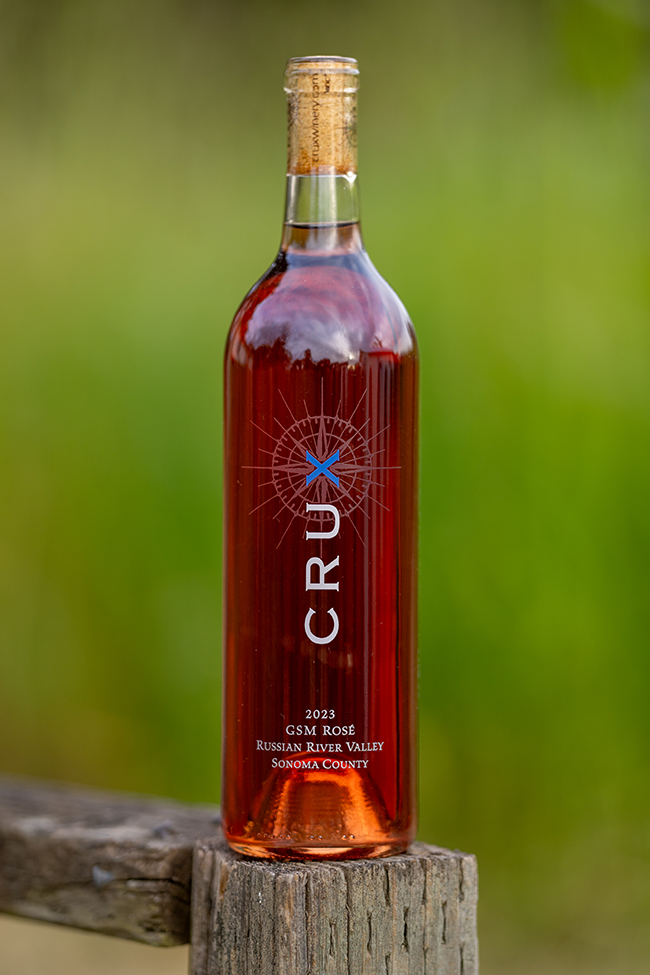SELECT A WINE:
VINTAGE
2023
2023 GSM Rosé

Nutrition Facts
5 servings per bottle
Serving Size 5oz (150ml)
Amount Per Serving
Calories 124
Total Fat 0g
Total Carbohydrates 3g
Protein 0.015g
Residual Sugar 0.6g
Ingredients: wine grapes (Grenache, Syrah, Mourvèdre), Lallemand Go-Ferm, Lallemand Fermaid O, IOC Inodose Pottasium Metabisulfite
About The Process
Our 2023 Rosé is a blend of 68% Grenache, 18% Syrah, and 14% Mourvedré grapes. As usual, we used the saignée process for the majority of the juice. Saignée is a French word meaning, “to bleed”, and is simply a process of removing some pre-fermentation juice from our Grenache, Syrah, and Mourvedre red wine fermentations. The is done quickly after destemming to maintain the light color. This process, while providing juice for the Rosé, also increases the skin to juice ratio of the red wine fermentations for increased flavor and tannin in the finished red wines. In addition to the saignée juice, the balance of the juice was direct pressed Grenache that was simply destemmed then pressed (separated from the skins) and moved straight to the fermenter. At that point, the first fermentation aid, Go-Ferm was added along with the yeast for fermentation. Links to Allergen, Food Safety, and Non-GMO statements are available here along with OMRI certification and data sheets:
https://scottlab.com/go-ferm-yeast-rehydration-nutrient-goferm
The fermentation became active after about 48 hrs, at which point, the second additive, Fermaid O was mixed into the juice. Similar information is provided with this link:
https://scottlab.com/fermaid-o-yeast-fermentation-nutrient-fermo
The fermentation process took another 5 week for the yeasts to consume all the natural sugars. We stirred the lees every couple of days and monitored fermentation progress by hydrometer (measures reducing sugar content) and “sniff tests”, which is simply monitoring aromatic, healthy fermentations smell wonderful. Struggling ones less so. Off aromas during fermentation are complete discussion for another day, we were happy none of these were present in this wine.
Upon dryness (in this case down to 4 grams of sugar per liter of wine), the wine was racked from the lees. At this point we add the first amount of potassium metabisulfite (commonly referred to as “sulfur” or “SO2”) at a concentration of 20 ppm. Potassium Metabisulfite functions as an anti-oxidant and for bacterial control in wine.
Links for Allergen, Food Safety, Non-GMO, and data sheets are available here:
https://scottlab.com/ioc-inodose-sulfur-dioxide-tablets-5-g-42-slash-bo-15776
To provide cold stability and aid in clearing of the wine, we reduced the temperature of the wine to 32 degrees for 8 days. This process drops tartrates from solution and settles the remainder of the lees. Following stabilization, the wine was filtered to remove any remaining yeast cells to prevent the chance of renewed fermentation after bottling.
Prior to bottling free SO2 was tested via lab analysis and adjusted to 22ppm. Free SO2 is basically a measured of SO2 available to protect the wine from oxygen damage during bottling and during bottle aging. The amount used was based on the wine pH to achieve a level of .85 mg/L molecular SO2.
Our 2023 Rosé was bottled in April of 2024.

Our Approach to Winemaking
With few exceptions, all of our white and red wines are treated the same with regard to additives and preservatives. Basically, it boils down to four products. Yeast is added to white wine fermentations only. Go Ferm and Fermaid O are branded products used as yeast nutritional aides (used with both added and native yeasts, white and red wines) derived from spent yeast hulls. Both products are Organic certified, vegan, and non-GMO. Finally, we use potassium metabisulphite as a preservative in our wines. It acts as an anti-oxidant and sterilant, in other words, it protects the wine from oxygen damage and bacterial growth. Typically the total added potassium metabisulphite is less than 150 ppm for red wines and 125 ppm for white wines. After production, aging, and bottling, our wine typically has 20 – 40 ppm of free SO2 (some potassium metabisulphite is bound or escaped to the atmosphere). Note that SO2 is the compound produced by potassium metabisulphite when added to wine. “Free” SO2 is essentially the remaining preservative available to protect and stabilize the wine during aging. We consider our addition levels to be the minimum safe addition to insure good aging potential without spoilage. Of the total free SO2 in our wines, a portion is naturally occurring during the fermentation process.
We do not add any form of inorganic nitrogen such as ammonia salts as a fermentation aid.
We don’t use “processing aids” like Velcorin (dimethyl dicarbonate) in any of our wines now or ever. Note that processing aids are allowed by the FDA for use without listing on the ingredients lists under the theory that they are no longer present in the wine after a certain period.
Filtration – while not a wine additive, we feel that this should be part of the discussion of wine additives. We do not prescribe any of our wines to be filtered as a standard practice. At this point, the only wine routinely filtered is our Rosé. This is done to eliminate dormant yeast cells from the resulting wine. These cells are common to any unfiltered wine and completely natural and harmless. However, if even low levels of residual sugar after present in a finished wine, the dormant yeast can “reawaken” and consume the remaining sugar leading to an unintentional, sparkling wine and associated problems with corks pushing up. While all of our wines are considered dry wines, the Rosé does not quite reach low enough residual sugar levels to be of no concern. Filtration removes the dormant yeast cells so a spontaneous mini refermentation is not possible.